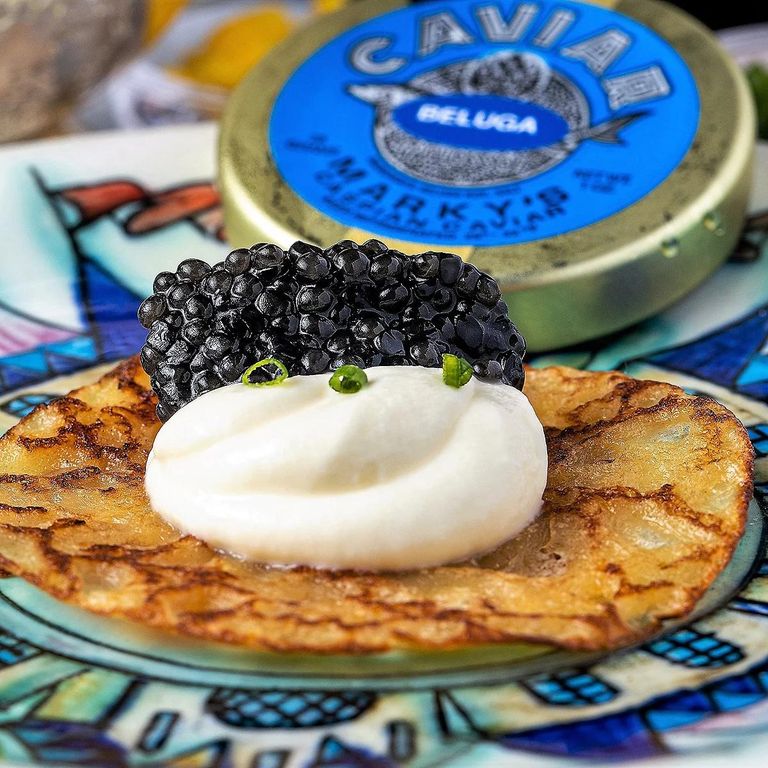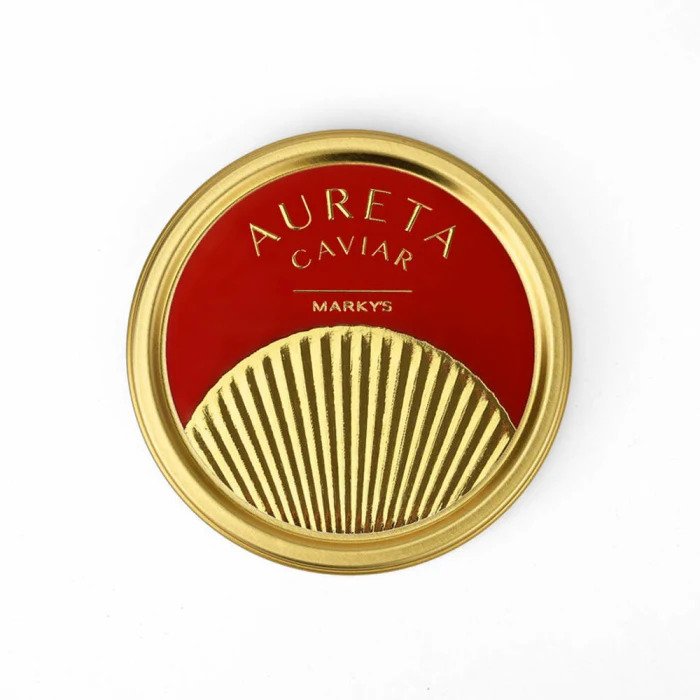Now it's the race that's wild, not the caviar - Marky's
By Jane Black The New York Times
WEDNESDAY, SEPTEMBER 27, 2006
ELVERTA, California Caviar from farmed sturgeon used to be a tough sell. Now it is tough to fill the orders.

Last month two airlines asked Sterling Caviar, which operates the largest caviar farm in the United States, for 15 tons of it, nearly double the annual production, said Peter Struffenegger, manager of the company's plant here in this dusty valley outside Sacramento.
No wonder then that for the first time since it began producing caviar in 1994, Sterling is this year conducting a second harvest. Traditionally, Sterling removed roe only in the spring, when white sturgeon, which have lived in the nearby Sacramento River for at least 80 million years, naturally spawn.
The autumn harvest will be the start of a global race to produce enough farmed caviar for the first holiday season since international environmental officials all but shut down the wild caviar market because of concerns about overfishing.
Struffenegger knows that if he cannot meet the demand, somebody else will. "A few years ago we were begging people to take farmed caviar seriously," he said. "Now there's worldwide interest and millions being spent just to meet demand."
In the mid-1990s, the farmed caviar industry was nothing more than a few marine biologists with a dream. Today it is emerging as a global, multimillion-dollar business. Sturgeon farms in France, Germany, Italy and Uruguay are investing millions of dollars to expand facilities and to develop new technologies, like microchip implants, to create roe with a pop as perfect and a flavor as buttery as traditional wild caviar's.
In Bulgaria, Canada, China, Israel and the middle of a desert in Abu Dhabi, fledgling caviar farmers are breaking ground on new production facilities. Marky's, a caviar distributor in Florida, is importing and breeding beluga, the finest sturgeon species, with a goal of having 500,000 fish by 2009.
If estimates are to be believed - and producers tend to be optimistic - farmed caviar production will almost double, from about 64 tons in 2005 to 125 tons in 2010.
The UN Convention on International Trade in Endangered Species refused this year to issue export quotas for wild caviar from sturgeon in the Caspian and Black Seas, other than a small amount of osetra from Iran.
Perhaps the most ambitious project to make up for the reduced supply is the farm in Abu Dhabi in the United Arab Emirates, which plans to breed Siberian sturgeon. Backed by private investors, the $48 million facility is scheduled to be completed by the end of 2008, with the first caviar expected to be sold the next year. At its peak, the farm expects to produce 32 tons annually, two times what is produced today in California.
Abu Dhabi may seem like an odd place to build a fish farm, but labor is cheap there and energy is cheaper. And there is a huge market for caviar on cruise ships that dock there, in the city's hotels and among the Arab elite.
Still, the project requires sophisticated water recirculation technologies to function in a desert. For the sturgeon to grow quickly and to produce eggs, for example, the water will need to be cooled to 20 to 22 degrees Celsius (68 to 72 degrees Fahrenheit). And none can be wasted. According to Christoph Hartung, chief executive of the German firm United Food Technologies, which has been hired to build and manage the farm, 95 percent of each day's water will be filtered and reused.
United, which has farmed sturgeon in Fulda, Germany, since 1990, created a subsidiary, AquaOrbis, in 1999 specifically to provide technology and management services to the growing number of new sturgeon farms.
"We've been overwhelmed by the interest, and we have a lot of bids out at the moment," Hartung said. AquaOrbis is also planning to help open a farm next year in Guangzhou, China.
More well-established farms are using impressive technology. At Agroittica Lombarda in Calvisano, Italy, the world's largest caviar farm, each female white sturgeon has a microchip containing its genetic information implanted in the back of its head. Besides noting the fish's parents and grandparents, other information is stored, like first recorded weight, pond of origin and diet.
Each time the fish is examined or moved, the digital record is updated. Its life history can be read by running a small scanner over its head. Such detailed records ensure that there is genetic diversity in the stock.
Agroittica's processing room looks like a hospital emergency room. The workers dress in white lab coats, surgical gloves and hairnets. To reduce bacterial contamination, the room is pressurized so that no outside air can enter while the eggs are being cleaned, weighed and salted. This, according to Agroittica's managing director, Sandro Cancellieri, extends shelf life and improves flavor, since less salt needs to be added for preservation.
But the technology that every farm is racing to develop is one that would determine the optimum moment to harvest the eggs. Harvest too early and the caviar will be rough and dry because the fat is still in the fish's belly, not the eggs. Harvest too late and the caviar will be soft and lack distinctive beads. (Wild caviar is always harvested at the ideal time because the sturgeon are caught as they swim upriver to their spawning ground.)
With farmed sturgeon, biologists must rely on educated guesses about when a fish will release its eggs. In general, baerii, or Siberian, sturgeon, the breed grown in farms in established European farms and newer operations in Asia and the Middle East, mature within five years. White sturgeon, grown in the United States and Italy, mature in eight.
To be sure, each fish must be individually biopsied. Marine biologists make a small incision, insert a plastic tube and manually suck a few eggs from each fish. If the test roe are black, the eggs are ready. If they are white, the fish will need about another year to reach full potential.
In France, farmers use ultrasound technology to speed the process. Alan Jones, managing director of a company called Sturgeon, based in Saint-Sulpice, Bordeaux, uses ultrasound scanners to determine the sex of his baerii sturgeon and to identify mature females that are ready for harvesting. (A sturgeon's gender is not evident until the fish is 3 years old.)
But does all this technology produce great caviar? For years connoisseurs would not touch farmed eggs, complaining that they tasted like dirty lake water or salty mush. And though processing and storage methods have improved, environmentalists have forced people to give the industry another chance.
"Everyone is thinking more about sustainability," Terrance Brennan, chef of the restaurant Picholine in New York City, said. "And while it's different than wild caviar, it's very good."






